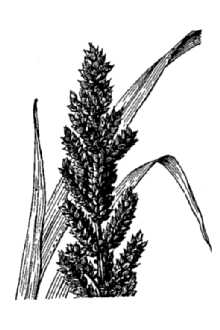Billion-dollar Grass
Scientific Name: Echinochloa frumentacea Link

| General Information | |
|---|---|
| Usda Symbol | ECFR |
| Group | Monocot |
| Life Cycle | Annual |
| Growth Habits | Graminoid |
| Native Locations | ECFR |
Plant Guide
Use soil moisture sensors to measure the soil moisture of Billion-dollar Grass.
Fact Sheet
Alternate Names
Echinochloa crus-galli (L.) Beauv. ssp. edulis A.S. Hitch.; Echinochloa crus-galli (L.) Beauv. var. frumentaceum Roxb., non Salisb.
Uses
Billion-dollar grass is an exceptional wildlife plant. It is a choice duck food and is eaten by 17 species of Northeastern waterfowl. This food is also used by five upland game birds and many non-game birds such as sparrows, finches, and cardinals. Leaves and seedheads are eaten by rabbits and muskrats. As an erosion control plant it is used as a quick growing companion crop with perennial grasses and legumes and is especially suited to wet sites.
Status
Please consult the PLANTS Web site and your State Department of Natural Resources for this plant’s current status (e.g. threatened or endangered species, state noxious status, and wetland indicator values).
Description
Billion-dollar grass is an introduced annual. It has coarse leaves and varies from one to five feet in height depending on available moisture and fertility. The seed-head is a compact panicle-type infloresence four to eight inches long, purplish in color, with awnless seed. Conversely, wild barnyard grass has seed with conspicuous awns and a more open-branched panicle. Billion-dollar grass produces a much heavier seed yield than the wild species. There are approximately 155,000 seeds per pound.
Adaptation and Distribution
Distribution , Use soil moisture sensors to measure the soil moisture of Billion-dollar Grass.
Distribution
This plant is widely adapted to the entire Northeast as it matures in 60-90 days. It grows well in wet soils but will also grow on well-drained upland soils. Billion-dollar grass is somewhat tolerant of low soil pH (4.5) and salinity of 2,000 parts per million. For a current distribution map, please consult the Plant Profile page for this species on the PLANTS Website.
Establishment
Seed may be drilled or broadcast and incorporated to a one inch depth on upland sites. In wetland areas, draw down water levels and broadcast seed on top of wet ground. Seeding rate for pure stands is 20 lbs./acre when drilled and 25-30 lbs./acre if broadcast. In a mixture reduce rate to 8-12 lbs./acre. Planting is recommended after the last killing frost in the spring. The seeding date may be timed to synchronize the maturity date of seed with the fall migration of specific migratory birds. USDA NRCS Manhattan Plant Materials Center Manhattan, Kansas
Plant Traits
Growth Requirements
| Temperature, Minimum (°F) | 37 |
|---|---|
| Adapted to Coarse Textured Soils | No |
| Adapted to Fine Textured Soils | Yes |
| Adapted to Medium Textured Soils | Yes |
| Anaerobic Tolerance | High |
| CaCO3 Tolerance | Medium |
| Cold Stratification Required | No |
| Drought Tolerance | Low |
| Fertility Requirement | Medium |
| Fire Tolerance | Medium |
| Frost Free Days, Minimum | 150 |
| Hedge Tolerance | None |
| Moisture Use | Medium |
| pH, Maximum | 7.4 |
| pH, Minimum | 4.7 |
| Precipitation, Maximum | 60 |
| Precipitation, Minimum | 18 |
| Root Depth, Minimum (inches) | 8 |
| Salinity Tolerance | Low |
| Shade Tolerance | Intolerant |
Morphology/Physiology
| Bloat | None |
|---|---|
| Toxicity | None |
| Resprout Ability | No |
| Shape and Orientation | Erect |
| Active Growth Period | Spring |
| C:N Ratio | High |
| Coppice Potential | No |
| Fall Conspicuous | No |
| Fire Resistant | No |
| Flower Color | Green |
| Flower Conspicuous | No |
| Foliage Color | Green |
| Foliage Porosity Summer | Dense |
| Foliage Porosity Winter | Porous |
| Fruit/Seed Color | Yellow |
| Fruit/Seed Conspicuous | No |
| Growth Form | Bunch |
| Growth Rate | Rapid |
| Height, Mature (feet) | 3.9 |
| Known Allelopath | No |
| Leaf Retention | No |
| Low Growing Grass | No |
| Nitrogen Fixation | None |
| Foliage Texture | Medium |
Reproduction
| Propagated by Seed | Yes |
|---|---|
| Propagated by Sod | No |
| Propagated by Sprigs | No |
| Propagated by Tubers | No |
| Fruit/Seed Persistence | No |
| Seed per Pound | 142880 |
| Seed Spread Rate | Rapid |
| Seedling Vigor | High |
| Small Grain | No |
| Vegetative Spread Rate | None |
| Propagated by Corm | No |
| Propagated by Container | No |
| Propagated by Bulb | No |
| Propagated by Bare Root | No |
| Fruit/Seed Period End | Fall |
| Fruit/Seed Period Begin | Summer |
| Fruit/Seed Abundance | High |
| Commercial Availability | Routinely Available |
| Bloom Period | Late Spring |
| Propagated by Cuttings | No |
Suitability/Use
| Veneer Product | No |
|---|---|
| Pulpwood Product | No |
| Protein Potential | Medium |
| Post Product | No |
| Palatable Human | No |
| Palatable Graze Animal | Medium |
| Palatable Browse Animal | Medium |
| Nursery Stock Product | No |
| Naval Store Product | No |
| Lumber Product | No |
| Fodder Product | Yes |
| Christmas Tree Product | No |
| Berry/Nut/Seed Product | No |
